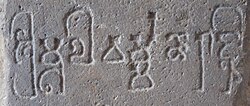Sri Mulavarman Nala Deva (spelled Mulawarman in Indonesian), was the king of the Kutai Martadipura Kingdom located in eastern Borneo around the year 400 CE. What little is known of him comes from the seven Yupa inscriptions found at a sanctuary in Kutai, East Kalimantan.[3] He is known to have been generous to brahmins through the giving of gifts including thousands of cattle and large amounts of gold. [4]

Reign
editHe was the grandson of Kudungga, and the son of Asvavarman, according to one of his inscriptions.[5] The sanctuary bears the name of the founder of the dynasty, Vaprakesvara.[6]: 52
The inscriptions of Mulavarman in Brahmi script on "yūpa" sacrificial posts are the earliest known evidence of Indian influence in the Malay World, in the fourth century CE, long before the region was Indianized.[7][8][9] The inscriptions of Mulavarman were followed about fifty years later by the inscriptions of another king, Purnavarman, in West Java.[7]
Inscriptions
editThe inscriptions of Mulavarman in Brahmi script were found on "yūpa" sacrificial posts.[7]
-
Mulavarman inscription on a yūpa, 5th century CE
-
Mulavarman inscription on a yūpa, 5th century CE
-
The word "Yūpo" in Brahmi in a Mulavarman Inscription, Muara Kaman, Kalimantan, 5th century CE
See also
edit- Mulawarman University, the state-university of East Kalimantan named after the king
- Kodam VI/Mulawarman, the military-district of the Indonesian Army covering East, South, and North Kalimantan named after the king
References
edit- ^ VOGEL, J. Ph. (1918). "The Yupa Inscriptions of King Mulavarman, from Koetei (East Borneo)". Bijdragen tot de Taal-, Land- en Volkenkunde van Nederlandsch-Indië. 74 (1/2): 167–232. ISSN 1383-5408. JSTOR 20769898.
- ^ VOGEL, J. Ph. (1918). "The Yupa Inscriptions of King Mulavarman, from Koetei (East Borneo)". Bijdragen tot de Taal-, Land- en Volkenkunde van Nederlandsch-Indië. 74 (1/2): 213. ISSN 1383-5408. JSTOR 20769898.
- ^ Hall, D.G.E. (1981). A History of South-East Asia, Fourth Edition. Hong Kong: Macmillan Education Ltd. p. 38. ISBN 0-333-24163-0.
- ^ Tarling, Nicholas (1999). The Cambridge History of Southeast Asia Volume 1 Part 1 From early times to c. 1500. Cambridge, England, United Kingdom: Cambridge University Press. p. 305. ISBN 0-521-66369-5.
- ^ VOGEL, J. Ph. (1918). "The Yupa Inscriptions of King Mulavarman, from Koetei (East Borneo)". Bijdragen tot de Taal-, Land- en Volkenkunde van Nederlandsch-Indië. 74 (1/2): 212. ISSN 1383-5408. JSTOR 20769898.
- ^ Coedès, George (1968). Walter F. Vella (ed.). The Indianized States of Southeast Asia. trans.Susan Brown Cowing. University of Hawaii Press. ISBN 978-0-8248-0368-1.
- ^ a b c Shome, Tony (2004). Malay Political Leadership. Routledge. p. 27. ISBN 978-1-135-78933-6.
- ^ Sircar, D. C. (1996). Indian Epigraphy. Motilal Banarsidass Publ. p. 212. ISBN 978-81-208-1166-9.
- ^ Mitra, Karabi (2011). "Religion in Pre-Islamic Indonesia". Proceedings of the Indian History Congress. 72: 1030. ISSN 2249-1937. JSTOR 44145714.
